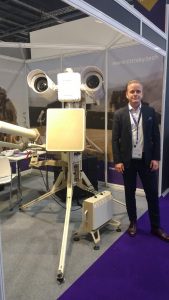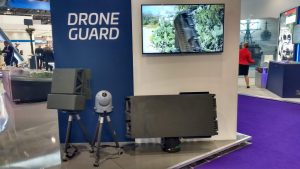By Jenny Beechener
Airport operators mulling over the best way to manage drone incursions found an array of solutions to choose from at the biennial Defence and Security Equipment International (DSEI) event in London 10-13th September 2019. Solutions ranged from integrated detection and mitigation systems to basic monitoring equipment, designed to help the operator make informed counter-UAS decisions.
Drawing on experience in the military sector, these companies are bringing field-proven technology to the civil sector.
Enhanced surveillance to detect small, slow moving drone targets is increasingly required in the civil sector. UK manufacturer Blighter Surveillance Systems exhibited its A400 series counter-drone air security radar with improved detection capability for low, slow and small unmanned aircraft systems (UAS) or drones. The company has increased the vertical elevation coverage from 30° to 40° and boosted the Digital Drone Detection (D3) technology to capture tiny radar reflections typically received from a drone such as a DJI Phantom. Blighter has also added an adaptable digital signal processing platform which enables the Ku-band radar to operate as a mobile unit.

Vice-President of Marketing Nick Booth told Unmanned Airspace to expect further developments over the next six months. “Customers are asking for extended range from 3.5 km to 5 km, and we are developing the micro-Doppler to identify and classify drones.” Currently surveillance information is used to que the camera so an operator to determine this, enhanced classification will lessen the load on the operator. Blighter e-scan radar is part of the Anti-UAV Defence System (AUDS) operating at London Gatwick and Heathrow airports since December 2018 to mitigate against drone incursions. The AUDS consortium also incorporates Chess Dynamics’ electro-optical video tracker, Enterprise Control Systems’ RF inhibitor, and Metis’ RF passive detector.
Advanced Protection Systems (APS), Polish manufacturer of ctrl+sky C-UAS, also exhibited an enhanced version of its surveillance capability. The company has partnered with UK electro-optics specialist Silent Sentinel showcased the new, military-grade 3D Radar sensor, with extended range (3km) and classification capabilities. 3D Radar sensor is utilising a hybrid AESA/MIMO architecture, and is integrated with military grade day vision and thermal camera technology. CEO Dr Maciej Klemm told Unmanned Airspace the technology is advancing faster than the regulatory environment at airports. “It doesn’t make sense to wait for an incident to happen. A drone is way more dangerous than a bird for an aircraft engine.” Dr Klemm said it is time for the airlines to join the discussion as they are most likely to recognise the risk posed by drones.

APS’s ctrl+sky system is installed and operating at Stavanger Airport, under a framework contract to Norwegian air navigation service provider Avinor to protect up to 15 airports, and is used at military facilities in Europe, the Middle East and Asia. The system includes four different types of technologies, as well as an integrated jammer capability and kinetic effectors. While Dr Klemm believes this type of solution offers valuable protection for small and medium-sized airports, he says the military market still dominates the business.
In a White Paper* published by US supplier DeDrone earlier this year, detection equipment installed at several UK airports revealed hundreds of drone incursions over a five-month period during 2018. Following the demonstration, London City and Edinburgh airports installed DeDrone RF sensors to monitor drone activity.
Another company focused on improving drone detection at airports, Swedish manufacturer Saab displayed its latest Giraffe ELSS (Enhanced, Low, Small and Slow) X-band surveillance radar and digital air traffic control solution at DSEI. The ELSS software add-on function detects all types of drones and operates simultaneously with standard detection capability across the company’s Giraffe range. Combined with Saab’s digital control tower, the data can be presented to the operational team to help determine what procedures to apply. CEO Saab Digital Air Traffic Solutions Per Ahl told Unmanned Airspace: “We see a growing interest in combining enhanced radar capability with digital tower services. It’s one thing to detect a drone, the next step is to decide what action to take.” The ELSS capability offers drone detection across the entire runway protection zone which typically extends up to 5 km from the threshold and 500 m either side to a height of 2,000 ft. “As drone numbers increase, establishing an operational concept around this operation at an airport becomes more important.”
Saab participates in EUROCAE Working Group WG100, tasked with developing standards for remote and virtual towers. Current activity includes setting minimum aviation system performance standards (MASPS) for target tracking technologies and optical systems. “By using digital information, we can display targets on screen and reduce the pressure on the operators,” said Ahl.
Communications specialist Frequentis also makes the connection with digital tower services, and has entered into a partnership with UAS service provider Altitude Angel to develop a harmonised framework for unmanned and manned traffic management. Earlier this year, Frequentis introduced a secure communications link between UAV pilots and air traffic control units in cooperation with Sunhillo to provide a common air situation picture. The UAS-C connection automatically enables UAS data to be visualised alongside other radar and Automatic Dependent Surveillance – Broadcast (ADS-B) targets in a UTM environment. UAS-C can be connected remotely via LTE or directly via a secure IP network connection and supports all types of UAV operations flying beyond visual line of sight (BVLOS), including flying in or through controlled airspace, regardless of size, altitude or mission.

Israeli manufacturer IAI made the transition from military to civil applications for its DroneGuard solution when it supplied equipment to Buenos Aires Airport in 2018 to provide protection for the duration of the G20 Summit. Applicable to large installations, DroneGuard comprises IAI’s solid state 3D X-band radar with a 4 km range, RF detector and electro-optics day/night camera. This also features an automatic target recognition algorithm capable of detecting the shape of the drone from the video. The company’s jamming technology includes a narrow 20deg low power beam which can be directed at a specific target. Regional Marketing and Sales Director Yoel Starovolsky reported growing interest from airports in Europe, Asia and the US in counter-drone technology. “We have completed some demonstrations,” he told Unmanned Airspace. “The system prevented several drone encroaching on Buenos Aires during the G20 Summit. Airports are looking for solutions and it is only a matter of time before this kind of equipment is deployed.”
*Dedrone White Paper: https://www.qolcom.co.uk/wp-content/uploads/2019/01/Dedrone_Airport_Airspace_Activity_Study_2018.pdf




